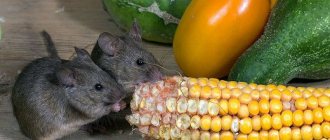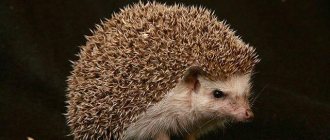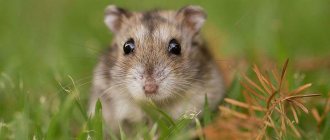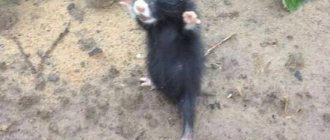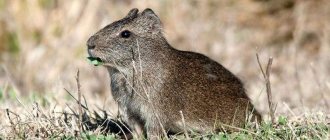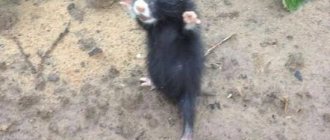The raccoon is an extremely cute animal. Recently, these pets have been kept as pets. This trend is also noticeable in Russia. People take them because of their appearance without doing any research about them.
In the future, people may have problems, since the raccoon is a wild animal. Not completely tamed. Before getting an animal, you should at least study the information provided about it in the public domain. We also recommend that you talk to raccoon owners.
They will be happy to tell you what it's like to live with a raccoon. Usually owners are only too happy to talk about their pets, boast about their achievements, and tell interesting features and habits.
Of course, you can keep a raccoon at home, but what instincts will it display? In the wild, they hibernate during the winter. What will the animal do at home during the winter season?
Raccoon sleeping in the wild
Raccoons are nocturnal animals. In nature they hunt at night. Be prepared for the fact that at first, the raccoon will not let you sleep, not having adapted to your routine. The animals quickly adapt and get used to the rules and laws in the house. There shouldn't be any problems.
If you adopt a raccoon at a young age, it will be easier to accustom your baby to a routine. Because kids always understand better than adults. It is difficult for adult pets to change anything in their lives. Raccoons respond well to training and education, so there is no need to worry. Believe in yourself and you will succeed! It’s difficult to call a pet’s sleep hibernation. The raccoon seems to be dozing. Doesn't go into suspended animation. This is also considered an interesting feature of raccoons. Animals actively store fat during autumn in order to stay indoors for as long as possible.
Raccoons don't sleep alone. They settle in 3-5 individuals. They do this to prevent other animals from stealing the house, or to prevent a sleeping animal from being attacked. The houses of raccoons and many other animals - small rodents - are robbed, since it is difficult for them to find food in winter.
The animal's sleep is quite intermittent. More like numbness. Metabolism does not slow down. All processes in the body occur as usual. We can say that raccoons do not even sleep, but doze. They usually sleep for 4-5 months.
If a raccoon goes outside, it will only be to slightly replenish supplies or just to take a walk and stretch its paws. It is somewhat reminiscent of an easy promenade. The animals come out on more or less warm days, when their paws are not so cold. Sometimes a raccoon may not sleep, but be in its house. The stronger the frost, the stronger the raccoon’s hibernation.
Greetings from Panama: tropical raccoons
We move on to a warm climate, and the question immediately arises: “Do raccoons go into suspended animation where the weather is constantly warm?” Yes, they still fall, but in very rare cases. In places where the air temperature does not drop below 12 degrees, raccoons are not prone to hibernation. The only thing that will remind you of the “sleepy period” is a slight decrease in activity, which is completely unnoticeable, except perhaps to an experienced person.
The animals that live in this tropical zone are light in weight and have hair with a small pile. If you compare a raccoon from the tropics and a raccoon from the north, the difference will be colossal.
In general, experts say that tropical raccoons have become an independent subspecies. Many people call these animals crustacean raccoons. Unlike the common striped raccoon, crayfish have smooth fur. It all depends on the climate, because the tropics are the warmest climate zone, so raccoons do not need to protect themselves from the cold with fluffy fur and a large layer of fat.
Winter in the tropics is characterized by heavy rainfall. Raccoons won't hibernate when it's just raining heavily. They will simply wait out the slushy weather in their cozy nest. Consequently, when the rainy season begins in the tropics, the raccoons simply doze in their hollow, waiting for excellent weather and that’s it.
Raccoon sleeping at home
If a raccoon lives at home with a person, then it does not need hibernation. The temperature at home is always the same. If he wants to take a nap (instinct will take over), he will fall asleep for a maximum of a couple of weeks.
This can happen in particularly severe frosts, when it can be felt even in a warm apartment. If your raccoon falls asleep, you should never wake him up. The animal's body knows better when to sleep. You can make a “mini house” for a raccoon. Cover it with a blanket ring to make the animal more comfortable. Better yet, don't even touch it.
After a nap, you may notice your pet's slight disorientation. This can be compared to how you feel in the morning. Don't worry, it will go away in an hour or two.
But after such a “mini-hibernation” the raccoon will be active and alert for a long time. The animal stores up its strength and its body, being cleansed, becomes better and stronger. After waking up, the raccoon is usually hungry, so it is worth feeding it.
Economic importance[edit | edit code]
The striped raccoon is a valuable fur-bearing animal. The first experiments on its breeding in the USSR were carried out in 1936, in the Caucasus, Central Asia, Belarus and the Far East. In Azerbaijan, the most successful raccoon acclimatization was in the Zakatala-Nukha Valley. The striped raccoon did not take root in the Primorsky Territory, although it existed here from 1937 to 1976[12]. After 1954, 486 raccoons were released in Primorye. But the raccoon dog turned out to be a strong competitor to the raccoon in the fight for local resources. The Far Eastern charza also appears to have been a factor in the failure of raccoon naturalization[6].
In the USA, the raccoon is a commercial species. In North America, under the most optimal conditions, the density of the species reaches 300 individuals per 1000 hectares: then raccoons often destroy fields, orchards, vineyards, melon fields and chicken coops, damaging farms. In Transcaucasia and Dagestan, raccoon density in some areas ranges from 20 to 30 individuals per 1000 hectares.
The animal can also be successfully bred in captivity. Animals with the sign of samson (cotton hair), which is a congenital defect in which matted downy hair is observed due to poorly developed awns, are culled.
The raccoon's coloring is ideal for nocturnal animals.
Photo: Joshua J. Cotten
Raccoons' thick fur is grayish-brown, and the tail has five to seven thin dark rings alternating with wider gray or brown rings. The tip of the tail is always dark. All raccoons have "bandit" masks on their faces - large black markings around each eye. The black “mask” extends from the edge of the nose to the bottom of the cheek. They also have whitish spots on the top of the eyes and around the nose. Raccoons have round ears edged with white fur. They have very dexterous front paws and are known to pick locks and reach into trash cans for food. Raccoons are excellent climbers, but not very fast swimmers.
Nutrition
The main search for food among raccoons is usually concentrated around water sources. They can catch fish, arthropods, frogs and some species of turtles.
Raccoons also love turtle eggs, hamsters, muskrats and musk rats. When hunting in the forest, the animal feeds mainly on insects, larvae, earthworms, fruits, berries, nuts and bird eggs.
Some regions suffer some damage due to the fact that raccoons regularly raid chicken coops and industrial poultry farming areas.
Raccoons, being predators, are not averse to eating rabbits, snails and squirrels. However, their diet also includes numerous berries, cherries, gooseberries, grapes, vegetables, grains and much more.
Classification[edit | edit code]
Currently, there are 22 subspecies of the striped raccoon (Procyon lotor)[13][14], including several island endemics, one of which became extinct in the middle of the 20th century:
- P. lotor auspicatus
- P. lotor elucus
- P. lotor excelsus
- P. lotor fuscipes
- P. lotor gloveralleni – Barbados raccoon†
- P. lotor grinnelli
- P. lotor hernandezii
- P. lotor hirtus
- P. lotor incautus
- P. lotor inesperatus
- P. lotor insularis – Tresmarias raccoon
- P. lotor litoreus
- P. lotor lotor
- P. lotor marinus
- P. lotor maynardi – Bahamian raccoon
- P. lotor megalodous
- P. lotor pacificus
- P. lotor pallidus
- P. lotor psora
- P. lotor pumilus
- P. lotor simus
- P. lotor vancouverensis
Planned weight gain
Preparing for winter sleep is a serious and responsible matter, and marmots are usually the first to hibernate. Throughout the summer, zoo specialists monitor their diet and weight gain dynamics. Since the marmots will not have access to food throughout the winter and part of the spring, they need to eat well during the summer. Animals use fat reserves to sleep through the cold season (which is almost four months) without harm to health.
If the groundhog does not have time to make enough supplies, then he risks not surviving the winter or waking up too early - even before the snow has completely melted and food appears.
Moreover, comprehensive preparations for winter are carried out not only by zoo specialists, but also by the rodents themselves. Since mid-August, marmots have been putting things in order in their burrow: removing excess sand and old straw, repairing underground corridors and insulating the sleeping chamber, where they will sleep until spring. To further protect the animals from the cold, zoologists will cover their surchina, that is, their hole, with a layer of straw. It will serve as both insulation and an insulating layer - if the snow melts, water will not seep into the hole.
There are seven species of raccoons
All raccoons are native to North and Central America. Their species vary only slightly in size and color. The North American striped raccoon is the most common species. It covers a huge range that includes southern Canada, most of the United States and parts of northern South America. Most other species live in tropical areas. During the 20th century, raccoons were introduced to other parts of the globe. Introduced species are now widely represented in countries such as Germany, the Russian Federation and Japan.
Animals in winter
Wild animals spend the cold period in different ways. Hares change their gray coats to white so that predators do not notice them in the snow. They jump along forest paths, eat twigs and tree bark, and take dry grass out from under the snow. The fox also grows a warm fur coat for winter. In the cold months, she feeds on mice, birds, hares, and steals chickens from chicken coops.
In summer, squirrels prepare their supplies in deep tree hollows. Thanks to this, in times of hunger they can easily find food for themselves. When cold weather sets in, the animals climb into their nests. Squirrels are in a semi-dormant state in winter and only come out to eat. Their fur coats also change color, they turn grey.
In winter, many rodents fall asleep. The exception is moles, which, due to their high metabolism, cannot go without food for a long time. The diet of these animals consists mainly of earthworms and insect larvae. To find food, moles dig holes at a depth of 5-10 cm. In the summer, they make provisions for the winter: they hide worms and larvae in certain places underground. When cold weather sets in, moles do not lose activity: they dig the ground, eat stored insects and look for new ones. In severe frosts, when the ground freezes, it becomes difficult to find food, so many of them die of hunger.
Animals that hibernate prepare for cold weather in advance. In order to safely survive a difficult period, in the summer they actively feed, accumulate fat reserves, and prepare shelters.
Their home is where the water is
Being a highly adaptable species, the raccoon lives wherever there is water. These furry bandits are found in swamps and farmlands, prairies, forests, urban and suburban areas adjacent to a water source.
Raccoons rarely set up a den more than a kilometer away from a permanent source of water. Streams and ponds are ideal habitats for raccoons, and in urban and suburban environments they will make dens near fountains, outdoor pools and drains.
Photo: jaimy van kessel
Raccoons are most active in the early evening and at night; they are rarely active during the day. However, when raccoons are in dire need of food, they leave the den during daylight hours. But in any case, they do not stray far from their home.
During the day, mammals take shelter in hollow trees, rock crevices, nests or burrows of other animals, and in warm weather they often find protected places to rest on the ground. Where raccoons have adapted to living in populated areas, they often take up residence in attics, chimneys and crawl spaces.
Their Latin name "lotor" means "gargle"
In addition to excellent night vision and acute hearing, raccoons have sensitive front paws. Having four times more tactile receptors on their front legs, they are able to sense food underwater and in the dark. In the absence of water, raccoons will move food through sand or snow before eating it. However, contrary to popular belief, raccoons do not wash their food to clean it. They are just used to getting food under water and they “pleasant” to feel it on their very sensitive paws.
Raccoons do not have opposable thumbs, and in fact their front paws are not like those of humans or primates. They are shaped like the paw of a weasel or ferret, but they do not have webbing between their front toes. The palms of the front paws are protected by a thin layer of horny skin, which becomes soft and pliable when wet.
Photo: www.foxnews.com
The little finger and thumb are offset from the middle three fingers and can meet in the middle of the palm, allowing the raccoon to grasp and manipulate objects with reasonable strength and exceptional dexterity. Raccoons can unscrew cans, undo locks, and even untie knots. And the joints of their hind legs can rotate 180 degrees, allowing them to climb down tree trunks headfirst.
Notes[edit | edit code]
- ↑ Sokolov V. E. Five-language dictionary of animal names. Mammals. Latin, Russian, English, German, French. / under the general editorship of academician. V. E. Sokolova. – M.: Rus. lang., 1984. – P. 97. – 352 p. – 10,000 copies.
- ↑ Alien species on the territory of Russia: Invasion of alien species: Mammals: Procyon lotor - Raccoon
- ↑ Hunters: raccoons and jackals threaten Sochi | Max Portal
- ↑ Emnr-Onknyaysm
- ↑ Raccoon Raccoon | Natalia Butrina's blog
- ↑ 1 2 3 Library - Rukovsky N.N. - In the footsteps of forest animals - Raccoon Raccoon - St. Petersburg Hunter, website about hunting, forums hunting, weapons, fishing, dogs, cartridges, animals, electronic...
- ↑ Club "Astrakhan Trophy". Raccoon Hunt
- ↑ Jackal Hunting
- ↑ BBC series: Life of Mammals. Episode 6 (inaccessible link). Access date: September 2, 2012. Archived August 3, 2012.
- ↑ Hunting the jackal.
- ↑ enot-doma.ru. How long do Raccoons live? Raccoon at Home.
- ↑ Who are raccoons?
- ↑ Procyon lotor Archived May 21, 2011 on the Wayback Machine in Wilson DE, Reeder DM (editors). 2005. Mammal Species of the World. A Taxonomic and Geographic Reference (3rd ed.). – Baltimore: Johns Hopkins University Press, 2 vols. (2142 pp.) ISBN 978-0-8018-8221-0. OCLC 62265494.
- ↑ Raccoon (English) according to the Integrated Taxonomic Information Service (ITIS).
Females give birth to cubs once a year
Males and females become reproductively mature at approximately one year of age; however, most males wait another year to breed because they are in strong competition with larger, older males. Mating season for raccoons typically occurs between January and June, depending on environmental conditions. In the northern regions, the peak mating season is from January to the end of March.
Since the male exhibits aggressive behavior towards the young, the female tolerates his presence only during mating and raises the young on her own. The gestation period is 63-65 days. Before giving birth in April or May, the female builds a nest, often using a tree hollow, chimney, or other cavity.
Swap enclosures and keep each other warm in winter
With a decrease in the average daily temperature, Moscow Zoo specialists began to gradually transfer heat-loving animals to indoor enclosures.
“All the monkeys moved to warm rooms, meerkats and capybaras practically don’t go out, giraffes began to walk less often. Although visitors can see all these animals in winter. Our bears already go outside only in the mornings - they are preparing for hibernation. Also at the zoo, marmots, raccoons, raccoon dogs, jerboas, chipmunks, dormouse and white-breasted hedgehogs go to sleep for the winter,” said Svetlana Akulova, director of the Moscow Zoo.
According to her, all animals are carefully prepared for winter sleep: they are given special high-calorie food, their weight is monitored and their premises are equipped.
At the same time, some zoo residents leave their summer “apartments” just before the onset of cold weather. This group includes, oddly enough, zebras and ostriches, which are traditionally associated only with warm climates. Pelicans also move to indoor pavilions closer to frost.
With the onset of cold weather, raccoons in the zoo go into hibernation. To keep each other warm, they gather in one house and fall asleep in one big company. Their distinctive feature is that raccoons, like bears, can wake up during the winter. Animals use this opportunity to refresh themselves or check whether spring has arrived.
Another interesting fact: Gentoo and Humboldt penguins switch their enclosures as winter approaches. And the point here is not at all in the temperature regime, but in the breeding season. In gentoo penguins it occurs in the summer, and in Humboldt penguins in the winter. Therefore, the latter move to the inner aviary of the Bird House pavilion, which is specially prepared for the breeding season.
Raccoons are constantly vigilant
The main enemies of raccoons are coyotes, wolves, bobcats, foxes, hawks and even owls. Individuals tend to avoid most predators by resting during the day in their dens or hiding in high branches, safely out of reach of at least some of their opponents.
If necessary, raccoons can accelerate up to 25 km/h. However, they will not be able to swim away from a waterfowl predator, since they do not have “waterproof” fur; When wet, the fur becomes heavy and limits movement.



